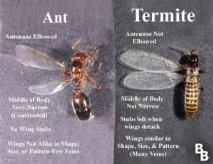
Some basic info on these bugs and why termite control is important:
Height / Weight: Measure between 4 to 15 millimeters in length. The queen of some species can measure up to over 4 inches in length.
- What do they do? Eat. They do it all day and night, 365 days of the year. They also build nests – the biggest insect nests in the world.
- What sort of food do they like? Dead plant material and cellulose, generally in the form of wood, leaf litter, soil or animal dung.
- Where do they live? All continents except Antarctica. Any wood they can find or the ground or nests.
- Are known as “silent destroyers” because of their ability to chew through wood, flooring and even wallpaper undetected. Each year, termites cause about 5 billion in property damage.
How do you tell the difference between ants and termites?

There are about 2,000 known termite species in the world, but there are 4 types that present the biggest threat to homeowners in the US: Subterranean, Drywood, Dampwood and Formosan.
Subterranean:
Picture:
- Found in every state except Alaska.
- Live in underground colonies or in moist secluded areas above ground.
- They build “mud tubes” to gain access to food and protect themselves when above ground.
- They use scissor-like jaws to eat wood 24 hours a day, seven days a week.
- These are the most destructive species in the US. Over time, they can collapse a building entirely.
- They swarm in the Spring when reproductive termites go off to start new colonies.
Drywood
- Found in southern tier states from North Carolina through the Gulf Coast into the coastal areas of California.
- They infest dry wood and do not require contact with the soil. They can establish nests in roof material, wooden wall supports and dead wood that may be around the home (wood piles). Also, can be found around water sources such as a leaky pipe or water heater.
- Can be transported to new locations via an infested piece of furniture, picture frame, etc.
- Can chew through support beams, floors and walls causing expensive home repairs.
- They are slow to chew but are much costlier to treat since the house must be tented.
- Also, dangerous since they are hard to detect with no mud tunnels (shelter tubes). They can only be detected by fecal matter (which a home owner can sweep or vacuum away) and/or damaged wood which is often behind walls.
- A home can be treated for Drywood termites and then still be re-infested the next swarm season.
Dampwood
- Found in Pacific coastal and adjacent states, the desert or semi-arid southwest and southern Florida.
- These infest wood with high moisture content.
- They do not usually infect structures due to low moisture content of wood in structures. Usually found in logs, stumps, dead trees, fence points and utility poles.
- Care must be taken to avoid attracting them to a structure – especially considering the moist / humid environment we live in here. Consider boat docks, piers over water. Especially a concern if living on the water.
- They are drawn to leaking faucets, water pipes and AC units on the outside of the home.
Formosan
- Found in Hawaii, North & South Carolina, Virginia, Texas, Louisiana, Alabama, Florida, Tennessee & California.
- These are the most voracious, aggressive and devious of all species.
- They are often referred to as “super termites”.
- They organize into huge underground colonies and build intricate mud nests inside the walls of structures.
- Very difficult to control once they infest a structure.
- The few isolated cases where detected in central and north-central Texas appear to be related to use of recycled railroad ties used as landscape timbers.
- Formosan termites build cartons in walls where they store water which allows them to avoid needing to return to the soil.
Signs of Termite Damage:
Mud Tubes (shelter tubes) on the exterior of the home
- Termite “Castles” on walls

- Soft wood in the home that sounds hollow when tapped
- Darkening or blistering of wood structures
- Uneven or bubbling paint
- Small piles of feces that resembles sawdust

- Small holes in wood with dust (frass) below or around them
- Discarded wings near doors or on windowsills indicating swarmers have entered the home (in spring)


How do we perform termite treatment?
At Texas Bugs, we provide a variety of termite control treatments to ensure we prevent and get rid of the termites.
New Home Construction Termite Control Treatments:
- Pre-pour foundation treatment
- Pre-sheetrock treatment
- Placement of Baiting Systems
Corrective Treatments
- The first step is a thorough inspection of the property to identify which type of termite is causing the problem. Depending on the type of termite a trench may be dug and/or holes may be drilled through concrete patios and soil will be treated with poison and refilled. For advanced termite infestations (or Drywood termites), tenting will be recommended. After the initial treatment, your Texas Bugs technician can return annually to ensure that your termite prevention is still functioning as intended.
Preventative Treatment for existing home
- We will treat your property with liquid applications, creating a protective barrier over your soil and preventing termites from consuming and living around and/or inside your home.
- From pre-construction soil treatments to preventing and eliminating infestations with post-construction applications, Texas Bugs offers you the ultimate in termite control services.
Other Wood Destroying Insects
Wood boring beetles
There are many types of wood destroying beetle. They vary in size, damage and wood preference. The life cycle of a beetle species can range from 2 months to 30+ years. The presence of adult wood-boring beetles may or may not indicate an infestation. Adult beetles are attracted to lights, windows and doorways where they may accumulate.

Source: Metallic Wood-Boring Beetle. Photo Credit: Michael Oestmann
Signs of infestation:
- The holes that beetles leave behind when they emerge.
- Presence of powdery material called frass which is a mixture of wood fragments and excrement. It usually piles below the holes or collects in structural cracks. It can be fine or coarse depending on the type of beetle.
- Stained or blistered wood surfaces caused by larvae tunneling just below the surface.
- Audible rasping or ticking sounds made by the larvae while chewing on wood.
Infestations can be managed, but it is critical to identify the beetles accurately because the management options vary by species.

Source: Wood beetle damage b y Ian Burt, via Flickr
Preventing Infestation:
- Begins when trees are harvested. When you buy wood, inspect it for exit holes or other signs of infestation. Use only wood that has been chemically treated.
- Control moisture in your home. Most wood infesting beetles cannot develop in wood that contains less than 15 percent moisture.
- Avoid bringing infested material into the home. Adult beetles can emerge from wood and infest structural wood or unfinished furniture. Stack firewood away from your home. Only bring in firewood that will be used immediately.
- Inspect antique furniture, picture frames, bamboo products and other wooden items before buying them. Treat any item that has borer holes or any other signs of infestation.
Eliminating infestations:
Methods: Replacing infested wood, killing the beetles with heat or cold, treating the wood surfaces with insecticides, or fumigating the structure. Using a professional is recommended.
Carpenter Ants
Often first noticed in late winter & early spring when they emerge to mate and attempt to start new colonies. The presence of winged ants indoors generally means that a nest is located in the structure. Among the larger ants found in Texas homes and yards. Most common species is 1/4 – 3/8 inch long. These ants use narrow, protected voids for nests and may be found in doors, window frames, and walls. Southern species prefer to nest in existing voids and cavities and do not usually excavate large nests in wood.
Texas carpenter ants are not as destructive as species found in the northwest and north eastern regions of US. At worst, they can may cause minor damage to isolated pieces of wood. However, these can be difficult to control. Nests can sometimes be located by presence of small piles of sawdust or frass (consists of wood shavings or other materials excavated from ant’s nest. This frass is a sign that the ant nest is nearby.
How do we kill these bugs?
This treatment often involves drilling holes in walls and injecting a chemical dust.


